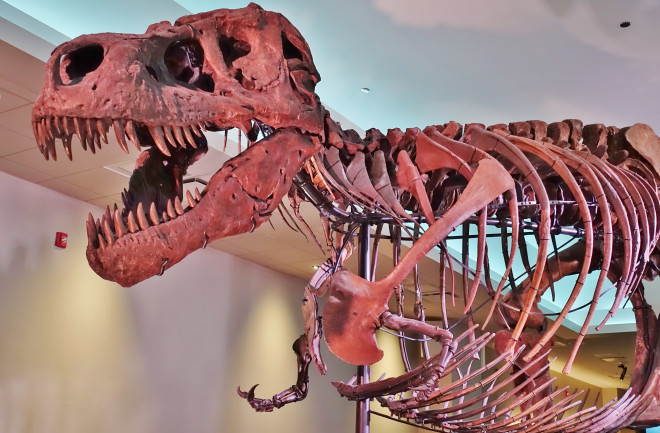The fierce Tyrannosaurus rex is well known for its boxy head, sharp teeth, and petite arms. But why did T. rex have such tiny arms and what did they use them for? Experts have developed various hypotheses for decades. Some say the tiny, seemingly useless appendages, which may have been too small to accomplish anything, might have been well adapted to give other dinosaurs a good slashing from a short distance.
Others suspect they were used for holding on to other T. rexes during mating rituals, to attract mates, for social behaviors, or to get off the ground if they were tipped over. One research team even suspected a T. rex could have bench-pressed about 400 lbs.
But other dinosaurs had arms that were even smaller than the T. rex's. Researchers think these small forearms were a remainder of evolution or a consequence of having more oversized heads.
1. Meraxes gigas
In 2012, paleontologists unearthed Meraxes gigas in Patagonia. Like T. rex (although not closely related), the dinosaur chowed down on meat and sported a large head with little arms.
After discovering the new dinosaur fossils, researchers suggested that these types of carnivores had big heads and puny arms because, as they evolved, their arms shrunk as a result of growing their signature bobble-like heads.
A giant head would have been advantageous because their heads were better suited to take down their prey. M. gigas weighed about 9,000 lbs. and measured 36 feet long.
Read More: Newly Discovered Dinosaur Has Short Arms Like The T. Rex
2. Carcharodontosaurus
Carcharodontosaurus was also a giant carnivorous dinosaur with a large head and tiny arms. It had 6-inch, serrated, shark-like teeth that were most likely used to rip off prey's flesh.
Like the T. rex and M. gigas, the giant dinosaur Carcharodontosaurus had smaller arms because of its large cranium. The large theropod roamed what is now known as the northern part of Africa during the Cretaceous period. The skull of this ferocious predator was assumed to be the longest ever found, measuring over five feet long.
Read More: Southern Africa's Mega-Carnivore: A Whole Lotta Dinosaur
3. Carnotaurus sastrei
As a unique type of dinosaur in the Abelisauridae family, Carnotaurus sastrei had even smaller forearms than the T. rex. First found in Patagonia in 1985, dinosaurs in this family were known for their tiny horns extending above their eyes.
But what C. sastrei lacked in arms, it made up for in its legs. Besides sporting horns and tiny forearms, this dinosaur was also a speedy sprinter. It might have been the fastest of the bigger-bodied theropods. Their speed-adapted bodies may have helped dinosaurs escape even bigger predators, such as Giganotosaurus carolinii. C. sastrei's speedy legs also aided in capturing smaller prey.
As for why this dinosaur had ridiculously small arms, experts suspect they were vestigial, where the limb became less used as the dinosaur evolved.
Read More: As Meat-Eating Hunters With Strong Jaws, Theropods Ruled the Mesozoic
4. Guemesia ochaoi
Like C. sastrei, Guemesia ochaoi is an abelisaurid but much smaller. First found in Northwestern Argentina, this dinosaur is the smallest abelisaurid. From a partially complete skull, scientists found that this dinosaur lived right before the dinosaurs were wiped from the planet. G. ochaoi might have sported their almost non-existent arms because they no longer needed them, like C. sastrei.
Read More: 5 Massive Dinosaur Fossils and Where They Were Found

